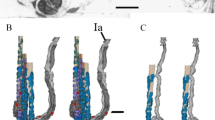Abstract
The effect of a polarizing current on electrical activity of the isolated frog muscle spindle was studied. A depolarizing current increased the frequency and reduced the amplitude of afferent spike activity, both spontaneous and evoked by mechanical stimulation. A hyperpolarizing current produced the opposite effect. The amplitude of the receptor potential in response to a mechanical stimulus varied as a linear function of the intensity of the polarizing current
Similar content being viewed by others
Literature cited
N. P. Alekseev, Electrophysiological Investigation of the Phases of the Receptor Potential of the Isolated Frog Muscle Spindle, Author's Abstract of Candidate's Dissertation, Leningrad (1969).
N. P. Alekseev and P. O. Makarov, "The hyperpolarization phase of the receptor potential of the isolated frog muscle spindle," Biofizika,14, 669 (1969).
N. P. Alekseev and P. O. Makarov, "Effect of metabolic inhibitors and ouabain on the receptor potential of the isolated frog muscle spindle," Biofizika,15, 93 (1970).
N. P. Alekseev, "Effect of tetraethylammonium ions on electrical activity of the isolated frog muscle spindle," Neirofiziologiya,4, 208 (1972).
O. B. Il'inskii and G. N. Akoev, "Action of a direct current on single mechanoreceptors," Dokl. Akad. Nauk SSSR,166, 1243 (1966).
A. L. Hodgkin, The Nervous Impulse [Russian translation], Mir, Moscow (1965).
B. I. Khodorov, The Problem of Excitability [in Russian], Nauka, Leningrad (1969).
D. A. Baylor and M. G. F. Fuortes, "Electrical responses of single cones in the retina of the turtle," J. Physiol. (London),207, 77 (1970).
H. M. Brown, S. Hagiwara, H. Koike, and R. M. Meech, "Membrane properties of a barnacle photoreceptor examined by the voltage clamp technique," J. Physiol. (London),208, 385 (1970).
I. Calma, "Ions and the receptor potential in the muscle spindle of the frog," J. Physiol. (London),177, 31 (1965).
J. C. Eccles, The Physiology of Synapses, Springer-Verlag, Berlin (1964).
C. Edwards, "Changes in the discharge from a muscle spindle produced by electrotonus in the sensory nerve," J. Physiol. (London),127, 636 (1955).
F. Emonet-Denand and J. Houk, "Some effects of polarizing current on discharges from muscle spindle receptors," Amer. J. Physiol.,216, 404 (1969).
M. G. F. Fuortes and G. F. Poggio, "Transient responses to sudden illumination in cells of the eye ofLimulus," J. Gen. Physiol.,46 435 (1963).
I. Husmark and D. Ottoson, "Ionic effects on spindle adaptation," J. Physiol. (London),218, 257 (1971).
I. Husmark and D. Ottoson, "Impulse activity of the isolated spindle in potassium-free solution," Acta Physiol. Scand.,83, 486 (1971).
A. F. Huxley and R. Stampfli, "Effect of potassium and sodium on resting and action potentials of single myelinated nerve fibers," J. Physiol. (London),112, 496 (1951).
F. Ito, "Effects of polarizing currents on long lasting discharges in the frog muscle spindle," Jap. J. Physiol.,20, 697 (1970).
B. Katz, "Depolarization of sensory terminals and initiation of impulses in the muscle spindle," J. Physiol. (London).111, 261 (1950).
R. Kikuchi, K. Naito, and I. Tanaka, "Effect of sodium and potassium ions on the electrical activity of single cells in the lateral eye of the horseshoe crab," J. Physiol. (London),161, 319 (1962).
O. C. Lippold, J. G. Nicholls, and J. W. T. Redfearn, "Electrical and mechanical factors in the adaptation of a mammalian muscle spindle," J. Physiol. (London),153, 209 (1960).
W. R. Loewenstein and N. Ishiko, "Effects of polarization on the receptor membrane and on the first Ranvier node in a sense organ," J. Gen. Physiol.,43, 981 (1960).
R. Millecchia and A. Mauro, "The ventral photoreceptor cells ofLimulus. III. A voltage clamp study," J. Gen. Physiol.,54, 331 (1969).
D. Ottoson, "The Effect of sodium deficiency on the response of the isolated muscle spindle," J. Physiol. (London),171, 109 (1964).
M. Ozeki, "Conductance change associated with receptor potential of gustatory cells in rat," J. Gen. Physiol.,58, 688 (1971).
J. B. Walter, "Single cell responses from the primitive eyes of an annelid," in: Berngard (Editor), The Functional Organization of the Compound Eye, Pergamon Press, Oxford (1965), pp. 329–336.
V. J. Vulff, "Modification of the receptor potential of theLimulus lateral eye by current and light," Physiol. Behav.,6, 513 (1971).
Additional information
A. A. Ukhtomskii Physiological Institute, Leningrad State University. Translated from Neirofiziologiya, Vol. 5, No. 1, pp. 95–101, January–February, 1973.
Rights and permissions
About this article
Cite this article
Alekseev, N.P. Effect of a polarizing current on receptor potential of the isolated frog muscle spindle. Neurophysiology 5, 77–82 (1973). https://doi.org/10.1007/BF01065216
Received:
Issue Date:
DOI: https://doi.org/10.1007/BF01065216




